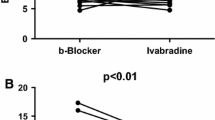Summary
The effect of long-term treatment with alprenolol on left ventricular function was investigated in a controlled double-blind study of 15 patients with ischaemic heart disease (alprenolol 6, placebo 9), by measurement of systolic time intervals (STI). Significant prolongation of QS2I was observed in patients treated with alprenolol (p<0.05), while changes in PEPI, LVETI and PEP/LVET were all insignificant. The heart rate x systolic blood pressure product (RPP) was significantly reduced in the alprenolol group (p<0.05). The data suggest that long-term treatment with alprenolol did not impair left ventricular function as evaluated by STI, and that myocardial oxygen demand, assessed by RPP, was reduced during the treatment.
Similar content being viewed by others
References
Reale A, Nigri A, Gioffré PA, Motolese M (1979) Acute influence of different beta-blocking agents upon left heart haemodynamics at rest and during exercise in patients with coronary artery disease. Eur J Cardiol 9: 101–109
Svendsen TL, Carlsen JE, Hartling O, McNair A, Trap-Jensen J (1980) A comparison of the acute haemodynamic effects of propranolol and pindolol at rest and during supine exercise in man. Clin Sci Mol Med 59: 465–468
Svendsen TL, Hartling O, Trap-Jensen J (1979) Immediate haemodynamic effects of propranolol, practolol, pindolol, atenolol and ICI 89,406 in healthy volunteers. Eur J Clin Pharmacol 15: 223–228
Lund-Johansen P (1979) Hemodynamic consequences of long-term beta-blocker therapy: a 5-year follow-up study of atenolol. J Cardiovasc Pharmacol 1: 487–495
Main in 'T Veld AJ, Schalekamp MADH (1982) How intrinsic sympathomimetic activity modulates the haemodynamic responses to beta-adrenoceptor antagonists. A clue to the nature of their antihypertensive mechanism. Br J Clin Pharmacol 13: 245S-257S
Nyberg G (1979) Effect of beta-adrenergic blockade on haemodynamic responses to dynamic and isometric exercise in angina pectoris. Eur J Clin Pharmacol 15: 381–388
Erbel R, Schweitzer P, Wagner G, Merx W, Effert S (1980) Evaluation of long term therapy with propranolol in mitral valve prolapse syndrome. In: List WF, Gravenstein JS, Spodick DH (eds) Systolic time intervals. Springer, Berlin Heidelberg New York, pp 256–264
Andersen MP, Frederiksen J, Bechsgaard P et al (1979) Effect of alprenolol on mortality among patients with definite or suspected myocardial infarction. Lancet 2: 865–868
WHO (1979) Ischaemic heart disease register. Copenhagen
Weissler AM, Lewis RP, Leighton RF (1972) The systolic time intervals as a measure of left ventricular performance in man. In: Yu PN & Goodwin JF (eds) Progress in cardiology. Lea & Febiger, Philadelphia, pp 155–183
Kryger P, Lublin H, Godtfredsen J (1979) Clinical employment of the systolic time intervals (STI). Report of a Danish normal material. Ugeskr Laeg 47: 1749–1752
Lewis RP, Rittgers SE, Forester WF, Boudoulas H (1979) A critical review of the systolic time intervals. Circulation 56: 146–158
Mostri G, Tomei G, Veltri M, Giusti C (1979) The effect of methoprolol on systolic times in patients with stable angina pectoris. Min Cardioangiol 27: 147–152
Boudoulas H, Lewis RP, Kates RE, Dalmangas G, Beaver BM (1980) Usefulness of the systolic time intervals in the study of beta-blocking agents. In: List WF, Gravestein JS, Spodick DH (eds) Systolic time intervals. Springer, Berlin Heidelberg New York, pp 243–255
Garrard CL Jr, Weissler AM, Dodge HT (1970) The relationship of alteration in systolic time intervals to ejection fraction in patients with coronary artery disease. Circulation 45: 529–533
Jorgensen CR, Wang K, Wang Y, Gobell FL, Nelson RR, Taylor H (1973) Effect of propranolol on myocardial oxygen consumption and its hemodynamic correlates during upright exercise. Circulation 48: 1173–1181
Gobel FL, Nordstrom LA, Nelson RR, Jorgensen CR, Wang Y (1978) The rate-pressure product as an index of myocardial oxygen consumption during exercise in patients with angina pectoris. Circulation 57: 549–556
Author information
Authors and Affiliations
Rights and permissions
About this article
Cite this article
Rasmussen, S.L., Pedersen, F. & Nielsen, P.B. Systolic time intervals during long-term beta-blockade with alprenol in ischaemic heart disease. Eur J Clin Pharmacol 25, 503–506 (1983). https://doi.org/10.1007/BF00542118
Received:
Accepted:
Issue Date:
DOI: https://doi.org/10.1007/BF00542118




